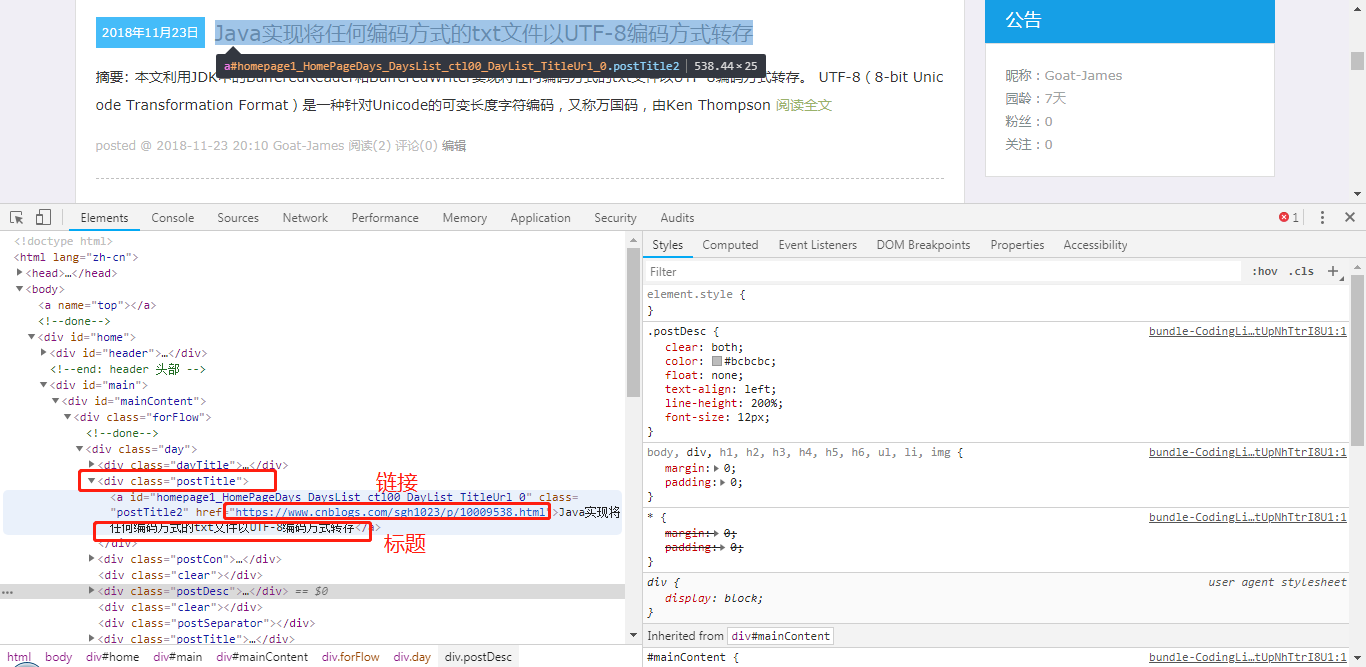互联网时代里,网络爬虫是一种高效地信息采集利器,可以快速准确地获取网上的各种数据资源。本文使用Python库requests、Beautiful Soup爬取博客园博客的相关信息,利用txt文件转存。
基础知识:
网络爬虫是一种高效地信息采集利器,利用它可以快速、准确地采集互联网上的各种数据资源,几乎已经成为大数据时代IT从业者的必修课。简单点说,网络爬虫就是获取网页并提取和保存信息的自动化过程,分为下列三个步骤:获取网页、提取信息、保存数据。
1.获取网页
使用requests发送GET请求获取网页的源代码。以获取百度为例:
import requests response = requests.get('https://www.baidu.com') print(response.text)
2.提取信息
Beautiful Soup是Python的一个HTML或XML解析库,速度快,容错能力强,可以方便、高效地从网页中提取数据。基本用法:
from bs4 import BeautifulSoup soup = BeautifulSoup(html, 'lxml') print(soup.prettify()) print(soup.title.string)
Beautiful Soup方法选择器:
find_all()查询符合条件的所有元素,返回所有匹配元素组成的列表。API如下:
find_all(name,attrs,recursive,text,**kwargs)
find()返回第一个匹配的元素。举个栗子:
from bs4 import BeautifulSoup soup = BeautifulSoup(html, 'lxml') print(soup.find('div', attrs={'class': 'article-list'}))
3.保存数据
使用Txt文档保存,兼容性好。
使用with as语法。在with控制块结束的时候,文件自动关闭。举个栗子:
with open(file_name, 'a') as file_object: file_object.write("I love programming. ") file_object.write("I love playing basketball. ")
分析页面:
要爬取的页面是博客园“我的博客”:https://www.cnblogs.com/sgh1023/。
使用Chrome的开发者工具(快捷键F12),可以查看这个页面的源代码。
HTML代码说白了其实就是一棵树,这棵树的根节点为html标签,head标签和body标签是它的子节点,当然有时候还会有script标签。body标签下面又会有许多的p标签、div标签、span标签、a标签等,共同构造了这棵大树。
可以很容易看到这个页面的博文列表是一个id为mainContent的div。

在class为postTitle的div里面可以找到链接和标题,这就是本文爬取的目标。

编写代码:
获取网页使用requests ,提取信息使用Beautiful Soup,存储使用txt就可以了。
# coding: utf-8 import re import requests from bs4 import BeautifulSoup def get_blog_info(): headers = {'User-Agent': 'Mozilla/5.0 (X11; Linux x86_64) ' 'AppleWebKit/537.36 (KHTML, like Gecko) ' 'Ubuntu Chromium/44.0.2403.89 ' 'Chrome/44.0.2403.89 ' 'Safari/537.36'} html = get_page(blog_url) soup = BeautifulSoup(html, 'lxml') article_list = soup.find('div', attrs={'id': 'mainContent'}) article_item = article_list.find_all('div', attrs={'class': 'postTitle'}) for ai in article_item: title = ai.a.text link = ai.a['href'] print(title) print(link) write_to_file(title+' ') write_to_file(link+' ') def get_page(url): try: headers = {'User-Agent': 'Mozilla/5.0 (X11; Linux x86_64) ' 'AppleWebKit/537.36 (KHTML, like Gecko) ' 'Ubuntu Chromium/44.0.2403.89 ' 'Chrome/44.0.2403.89 ' 'Safari/537.36'} response = requests.get(blog_url, headers=headers, timeout=10) return response.text except: return "" def write_to_file(content): with open('article.txt', 'a', encoding='utf-8') as f: f.write(content) if __name__ == '__main__': blog_url = "https://www.cnblogs.com/sgh1023/" get_blog_info()
爬取结果:

